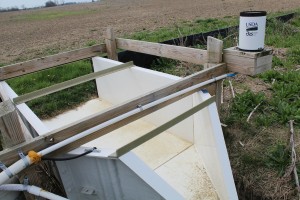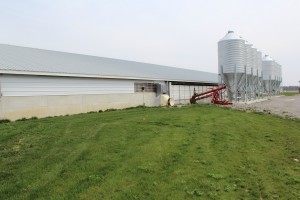GROVER HILL, Ohio — Over the past few years, the northwestern part of Ohio has become the focus for much of the state’s water quality concerns.
Paulding County grain and livestock farmer Terry McClure has lived and farmed in the Western Lake Erie Basin all his life — and he’s well aware of the harmful algae that’s showing up in Lake Erie.
He’s been an advocate for better conservation from the start, and a few years ago, he became one of the first farmers in the state to voluntarily open his fields to edge-of-field testing.
Research project
Scientists from the U.S. Department of Agriculture and Ohio State University are collecting and analyzing water runoff from certain fields on his farm, to determine how much nutrients are leaving, and identify different farming practices that influence nutrient loss.

So far, scientists have collected about three years of base data, and are beginning to run experiments to compare and contrast different farm practices.
There are many variables that affect the results, but in the end, there will be some clear answers.
And answers are what McClure and his family want — so they know what’s really happening — and how to adjust. They’ve taken a big risk, but feel it’s better than relying on other research, which was based on modeling and assumptions.
“Right or wrong, we need an answer here,” McClure said. “We don’t know what we’re going to find. It might be pretty damning evidence we find, but we need to know.”
The results
Terry and his son, Ryan, along with Terry’s father, Darwin, have been making conservation-minded improvements to the farm since Darwin started farming in about 1955. Over the years, they’ve grown the operation to include a contract swine finishing operation, and most recently, a beef finishing operation.

The livestock are housed in modern barns, and most of the manure is injected when applied to fields. Tillage is kept to a minimum, with a combination of no-till and light-duty tillage, and the McClures use buffer strips, cover crops and tile drainage to control water flow.
When they apply fertilizer, the focus is on the right time and rate, and making sure it has good contact with the soil.
Drainage efforts
In truth, water drainage and conservation have long been part of the region’s history — going back to the time when it was known as the Black Swamp, and later drained by settlers and early farmers.
Darwin, who will turn 81 this summer, doesn’t go back quite that far, but he remembers the work his family and other farmers did to tile the area, and make it better for farming and conservation.
At first, farmers tried to plow, he said, and many were losing dirt and finding the ground turned to an almost cement-like soil when it rained. Over the years, tiles have improved, the yields have improved and so has the water management.
Even in Terry’s time, he remembers as a boy, watching the federal government come in and channelize the creeks, and the installation and replacement of outdated field tile.
Now, he’s committed to keeping the land productive, and making sure nutrients stay where they’re needed.
Industry leaders
But conservation is just one thing this progressive farm is known for. Another is leadership.
Long before he opened his farm to research, Terry was president of Ohio’s largest farm organization — the Ohio Farm Bureau Federation, in the early 2000s, and is a former board member of American Farm Bureau. Ryan is currently president of the Paulding County Farm Bureau, and is a director on the Ohio Pork Council.
Today, the farm balances both crop and livestock production, finishing about 18,000 head of swine a year for Cooper Farms, and about 180 head of Holstein beef, under the name West Branch Cattle.
Getting to those numbers took time, and some risk.
Darwin and his wife, Sharon, raised hogs on the farm in the farm’s early days — but nowhere near as many, and not with the same efficiency.
Terry’s parents did not always have the best memories of raising hogs, and when he decided to finally build a commercial barn in 2004, they weren’t sure of the decision.
His mother, in particular, remembered the hard work of having to carry five-gallon buckets of water from the house to the barn, because the water at the barn was frozen, and trying to keep baby piglets warm during winter, by bringing them inside the furnace room.
More efficient
But the new barns solved those problems and brought new efficiencies, like automated feeding and climate control. The modern barns allow the McClures to raise more swine, with less time.
“It’s all due to efficiency and building things that are controlled, compared to doing it by hand,” said Ryan.

But Terry said they still go into the pens at least twice a day, to check on the welfare of the hogs and make sure that none are down. Visitors can’t enter the barns, for biosecurity reasons, but they can get a good view of what’s inside, through a large viewing window inside the barn.
Finishing beef
On the beef side of the farm, the McClures buy 300-pound feeders and finish them inside a barn equipped with automated feeding. The finished cattle are sold to a packer in Michigan.
Ryan originally started with three head of beef when he was a boy, worked his way up to 30 head, and now finishes 180. The larger herd size lets him contract his sales, and because his barns have become more efficient, he can feed more cattle in the same or less time.
On the crop side of things, the McClures continue striving toward better yields and better conservation, while remaining open to growth and adding new ground when it makes sense.
“We farm a new piece of dirt every year,” Ryan said. “Some years, more than others.”
This year will see tighter margins than farmers saw a few years ago, but the McClures kind of expected it.
“We expect this in a commodity world,” Terry said. “It’s almost an expectation that times are good, and then they’re going to be not so good.”
Looking ahead
The McClure family continues to grow. Ryan and his wife, Nikki, have four children of their own, and the oldest two are starting to help on the farm.
And the McClures have a good adviser, with Darwin still active on the farm. Terry said his dad knows which farms were well cared for over the years, and points them out when they drive past.
In general, there are a lot of farms in the area making conservation improvements, as they try to find answers to the nutrient issue.
Terry has seen a lot of teamwork, among farmers, industry and the government.
“I’m very proud of the Western Lake Erie Basin — the way we went at this,” he said. “The key here is to keep everybody working together, and we’ll improve things.”
Related coverage:
USDA says voluntary water quality efforts are working, supports additional steps (March 29, 2016).










